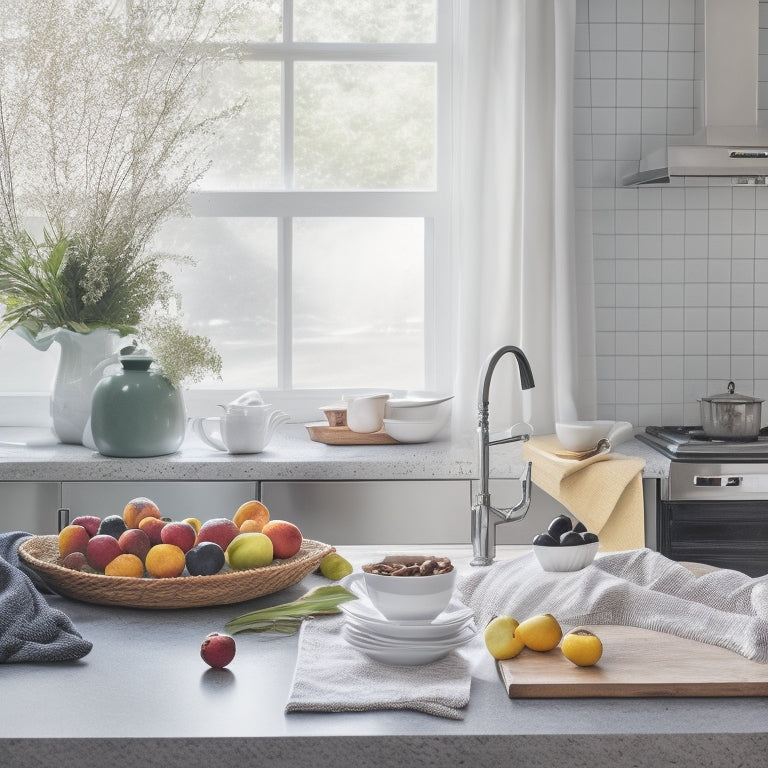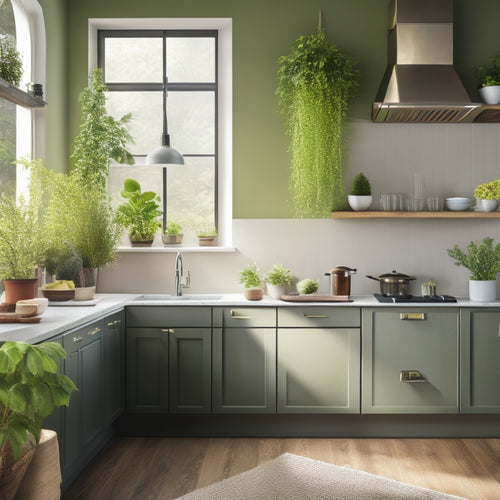
Plan Your Meals Declutter Your Kitchen Easily
Share
You're tired of kitchen clutter and meal time chaos. To break free, start by utilizing meal planning apps to streamline your process, keeping track of nutrition goals and maintaining a pantry inventory. Simplify kitchen tasks with technology, using smart gadgets and digital recipe collections. Next, declutter your kitchen by tackling countertops, cabinets, and pantry, and categorizing items for easy access. By streamlining your grocery shopping and reducing food waste with planning, you'll be on your way to a stress-free kitchen. Now, take the next step to transform your kitchen into a haven of efficiency and healthy meal planning.
Key Takeaways
• Use meal planning apps to organize recipes, create grocery lists, and track nutrition goals for a streamlined kitchen.
• Declutter your kitchen by categorizing items, using dividers, and storing food in labeled bins to maximize accessibility.
• Align your grocery list with your meal plan and kitchen inventory to reduce waste and save money.
• Implement smart kitchen gadgets and digital recipe collections to simplify cooking and meal planning tasks.
• Plan meals, store food properly, and label leftovers to reduce food waste and minimize environmental impact.
Meal Planning Apps for Organization
You can streamline your meal planning process by utilizing one of the many meal planning apps available, which can help you organize your recipes, create grocery lists, and keep track of your nutrition goals. These apps are designed to make meal planning efficient, saving you time and reducing food waste.
With features like recipe sharing, you can easily share your favorite recipes with friends and family, or discover new ones from a community of users. You can also keep track of your pantry inventory, ensuring you always have the ingredients you need on hand. By having a clear picture of what you have in your pantry, you can avoid buying duplicates and reduce clutter in your kitchen.
Simplify Kitchen Tasks With Technology
From meal planning to grocery shopping, technology can automate and simplify a multitude of kitchen tasks, freeing up your time for more enjoyable pursuits.
You can utilize smart kitchen gadgets, such as slow cookers and instant pots, to prepare meals with minimal effort. These gadgets can be controlled remotely, allowing you to cook a delicious meal while you're away.
Additionally, digital recipe collections can help you organize and access your favorite recipes with ease. You can search, save, and categorize recipes, eliminating the need for cluttered recipe books or scattered notes. With digital recipe collections, you can also easily scale recipes, convert units, and generate grocery lists.
Online Meal Planning Courses Available
Online meal planning courses offer a wealth of resources and guidance, providing access to expert advice, customizable plans, and community support to help you develop a personalized approach to meal planning.
These courses are designed to help you take control of your kitchen and make meal planning a breeze. With a wealth of budget-friendly meal ideas, you'll be able to create delicious and affordable meals that fit your lifestyle.
In addition to providing expert advice, online meal planning courses also offer quick meal prep tips to help you save time and energy. You'll learn how to prep ingredients in advance, cook meals in bulk, and create a schedule that works for you.
With these skills, you'll be able to whip up healthy meals in no time, even on the busiest of days.
Decluttering Your Kitchen With Ease
Three key areas to tackle when decluttering your kitchen are the countertops, cabinets, and pantry, as these spaces tend to accumulate the most clutter and disorganization.
Start by clearing everything off your countertops and sorting items into categories, such as baking supplies, cooking utensils, and appliances. Be ruthless – if you haven't used it in the past year, it's probably safe to get rid of it.
Next, tackle your cabinets by grouping similar items together and assigning a home for each group. Use dividers or baskets to keep items organized and easy to access.
When it comes to pantry organization, focus on categorizing food items by type, such as grains, canned goods, and snacks. Use storage bins and labels to keep items visible and easy to find.
Streamline Grocery Shopping Process
You'll want to create a grocery list that aligns with your meal plan and kitchen inventory to avoid buying duplicate items and reduce food waste. This will help you stay focused on the essentials and avoid impulse buys.
Review your meal prep strategies and identify the ingredients you need for the week. Make sure to include budget-friendly recipes that fit your dietary goals and preferences.
Next, categorize your list by aisle to optimize your shopping trip. Consider shopping online or using a grocery delivery service to save time and energy.
You can also use cashback apps or loyalty programs to maximize your savings.
Reduce Food Waste With Planning
By planning your meals and making a corresponding grocery list, you're taking the first step in reducing food waste by ensuring that every ingredient serves a purpose. This approach helps you avoid buying unnecessary items that often end up expiring or going bad. As a result, you'll save money and reduce your environmental impact.
Proper food storage is also vital in reducing waste. When you prep your meals, make sure to store them in airtight containers to keep them fresh for a longer period. Labeling your containers can also help you identify what you have in the fridge and pantry, allowing you to use up older items before they expire.
Meal prep is another effective way to decrease food waste. By preparing your meals in advance, you can use up all the ingredients you've purchased, minimizing the likelihood of leftovers going to waste. Additionally, meal prep saves you time during the week, and you'll be more likely to stick to your meal plan, reducing the temptation to order takeout or eat out.
Kitchen Organization Made Simple
With a solid meal planning strategy in place, it's time to turn your attention to the physical space where all the action happens - your kitchen - and get it organized in a way that supports your new habits.
You've planned your meals, now it's time to create a kitchen environment that makes cooking and preparing meals a breeze. Start by tackling pantry organization. Remove everything from your pantry and sort items into categories. Get rid of expired or unused items and group similar foods together. Assign a home for each item, making sure everything is easily accessible.
Next, focus on kitchen storage. Utilize vertical space by installing shelves or hooks for infrequently used items. Keep frequently used items in easy-to-reach locations. Consider investing in a kitchen cart or island to increase counter space and storage.
Create Healthy Meal Plans Easily
Six essential steps can help you create a healthy meal plan that suits your taste preferences and dietary needs.
First, define your dietary goals and restrictions.
Next, plan your meals for the week, considering breakfast, lunch, dinner, and snacks.
Then, make a grocery list based on your meal plan, ensuring you have all the necessary ingredients. You can also explore meal prep options, such as cooking meals in advance and freezing them for later use.
Fourth, organize your recipes and consider sharing them with friends or family members who share similar dietary needs. This won't only save you time but also provide you with a sense of community and accountability.
Fifth, schedule your meal prep and cooking sessions, and finally, track your progress and adjust your plan as needed.
Frequently Asked Questions
How Do I Involve My Family in the Meal Planning Process?
You involve your family in meal planning by considering their preferences and creating meal rotations together. Try creative theme nights and collaborative menus to keep things exciting and make sure everyone's input is valued.
What if I Have Specific Dietary Restrictions or Allergies?
When dealing with specific dietary restrictions or allergies, you'll adapt by finding recipe substitutions and opting for allergen-friendly options, ensuring everyone's safety and satisfaction in meal planning.
Can Meal Planning Really Help With Weight Loss Efforts?
You've wondered if meal planning can truly boost weight loss efforts; the answer is yes! By mastering portion control and meal prep, you'll make healthy swaps and optimize your pantry organization, leading to a slimmer, healthier you.
How Often Should I Review and Update My Meal Plans?
You should review and update your meal plans through weekly check-ins and monthly adjustments, incorporating seasonal menu rotations and ingredient substitutions to keep your diet fresh and aligned with your weight loss goals.
Are There Any Meal Planning Methods for Special Occasions?
"As you don the cloak of a master chef, remember that special occasions demand special plans. For holiday feasts, create a party menu tailored to your guests' tastes, and don't be afraid to get creative with seasonal ingredients."
Related Posts
-

3 Essential Steps to a Clutter-Free Kitchen
You'll reach a clutter-free kitchen by following three essential steps. First, purge and declutter by gathering items...
